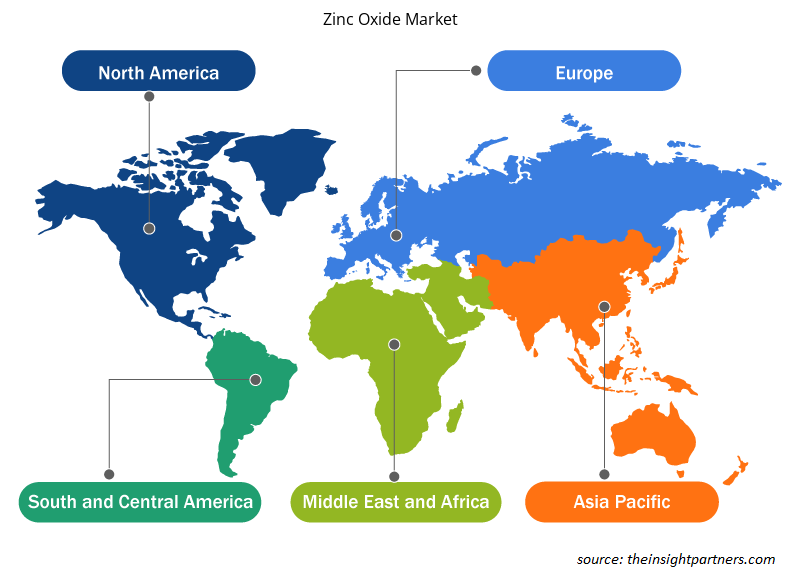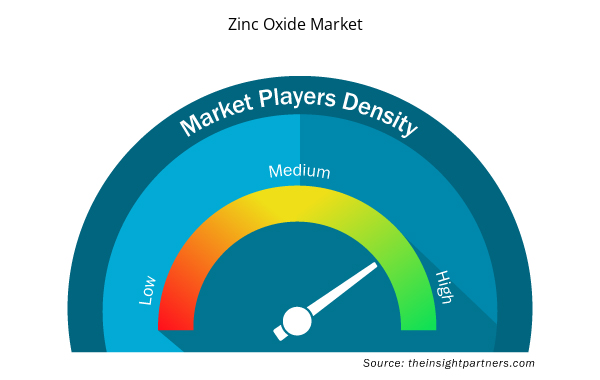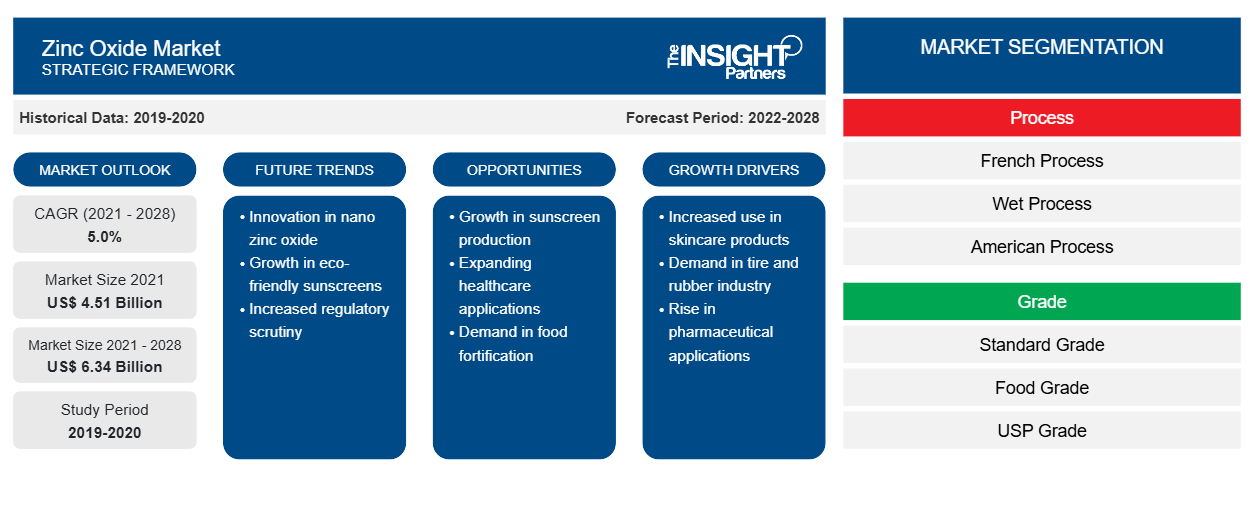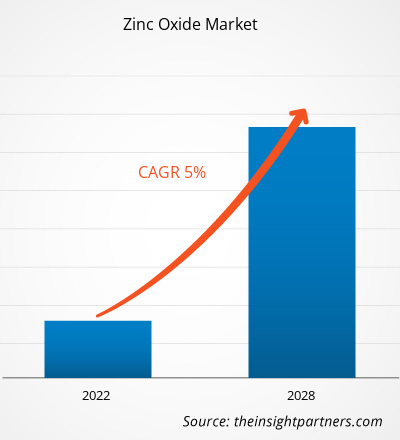酸化亜鉛市場規模は2021年に45億651万米ドルと評価され、2028年には63億3882万米ドルに達すると予測されており、2021年から2028年にかけて5.0%のCAGRで成長すると予想されています。
酸化亜鉛は、化学式ZnOの無機化合物です。水に溶けない白い粉末で、さまざまな材料や製品の添加剤として広く使用されています。さらに、ZnOはゴムの加硫に使用され、耐久性を高めます。タイヤ業界では、この加硫ゴムをさらに使用してタイヤを製造しています。タイヤの生産増加により、ゴム業界は世界で生産されるZnOの半分以上を消費しました。さらに、スマートデバイスの生産増加と、メイクアップ、ベビーローション、パウダー、バスソープなどの化粧品やパーソナルケア製品での酸化亜鉛の利用が、酸化亜鉛市場の主要な推進力となっています。また、日焼け止めなどのOTC医薬品の増量剤、着色剤、皮膚保護剤としても使用されています。
さらに、酸化亜鉛は、自動車エンジンの潤滑油の添加剤として広く使用されており、酸化腐食や摩耗を軽減します。酸化亜鉛は、極圧潤滑剤、耐焼付き潤滑剤、グリースなど、さまざまな種類の潤滑剤の製造に使用されます。したがって、上記の製品の需要が高く、それぞれの業界は好調に成長しています。たとえば、Statistaの調査によると、2021年に化粧品業界は世界中で約810億米ドルの収益を上げ、前年比で約8%の成長を記録しました。同様に、Statistaのレポートによると、2021年の自動車用潤滑油は702億米ドルの収益を記録し、2020年と比較して約5%増加しました。このように、酸化亜鉛の幅広い用途がその消費率を高め、市場の成長を牽引しています。
要件に合わせてレポートをカスタマイズする
このレポートの一部、国レベルの分析、Excelデータパックなど、あらゆるレポートを無料でカスタマイズできます。また、スタートアップや大学向けのお得なオファーや割引もご利用いただけます。
- このレポートの主要な市場動向を入手してください。この無料サンプルには、市場動向から見積もりや予測に至るまでのデータ分析が含まれます。
COVID-19パンデミックが酸化亜鉛市場に与える影響
COVID-19パンデミックは、世界中のさまざまな産業の成長にかなりの混乱を引き起こしました。同様に、COVID-19パンデミックは2020年に酸化亜鉛市場に大きな影響を与え、商品輸送の制限により酸化亜鉛原料のサプライチェーンが妨げられました。いくつかの国でロックダウン規範が緩和され、製薬業界が成長したことで、酸化亜鉛の世界的な需要が持続しました。これに加えて、COVID-19ワクチン接種プログラムの急速な進展と、世界的な医薬品への酸化亜鉛の採用の増加により、酸化亜鉛市場の成長が促進され、酸化亜鉛メーカーは事業の大幅な成長を目の当たりにしています。
市場洞察
農業におけるグリーン酸化亜鉛ナノ粒子の需要増加
世界中で無農薬食品の需要が高まる中、大気汚染物質を残さず従来の化学的方法に代わる安全な方法として、グリーン酸化亜鉛ナノ粒子の消費が増加しています。酸化亜鉛ナノ粒子は発芽に効果があり、植物の発育を促進します。また、土壌の養分を吸収することなく、茎と根の成長率を高める効果もあります。グリーン酸化亜鉛ナノ粒子の土壌再生特性と作物の収穫量増加により、グリーン酸化亜鉛ナノ粒子の需要は徐々に増加しています。
プロセスインサイト
プロセスに基づいて、世界の酸化亜鉛市場は、フランス式プロセス、湿式プロセス、アメリカ式プロセス、その他に分類されます。フランス式プロセスセグメントは、2020 年に世界の酸化亜鉛市場をリードしました。フランス式プロセスは間接プロセスとも呼ばれ、このプロセスでは、亜鉛は炉で溶融され、910 度で気化されます。亜鉛蒸気が空気中の酸素と直接反応して、酸化亜鉛が生成されます。
グレードインサイト
グレードに基づいて、酸化亜鉛市場は標準グレード、食品グレード、USPグレード、その他に分類されます。標準グレードセグメントは、2020年に世界の酸化亜鉛市場をリードしました。標準グレードの酸化亜鉛は、実験中の参照標準として、研究室、研究、開発部門で広く使用されています。標準グレードの酸化亜鉛は、高品質で純粋な酸化亜鉛です。
酸化亜鉛市場の地域別分析
予測期間を通じて酸化亜鉛市場に影響を与える地域的な傾向と要因は、Insight Partners のアナリストによって徹底的に説明されています。このセクションでは、北米、ヨーロッパ、アジア太平洋、中東、アフリカ、南米、中米にわたる酸化亜鉛市場のセグメントと地理についても説明します。

- 酸化亜鉛市場の地域別データを入手
酸化亜鉛市場レポートの範囲
| レポート属性 | 詳細 |
|---|---|
| 2021年の市場規模 | 45億1000万ドル |
| 2028年までの市場規模 | 63.4億米ドル |
| 世界のCAGR(2021年~2028年) | 5.0% |
| 履歴データ | 2019-2020 |
| 予測期間 | 2022-2028 |
| 対象セグメント | プロセス別
|
| 対象地域と国 | 北米
|
| 市場リーダーと主要企業プロフィール |
|
酸化亜鉛市場のプレーヤー密度:ビジネスダイナミクスへの影響を理解する
酸化亜鉛市場は、消費者の嗜好の変化、技術の進歩、製品の利点に対する認識の高まりなどの要因により、エンドユーザーの需要が高まり、急速に成長しています。需要が高まるにつれて、企業は提供品を拡大し、消費者のニーズを満たすために革新し、新たなトレンドを活用し、市場の成長をさらに促進しています。
市場プレーヤー密度とは、特定の市場または業界内で活動している企業または会社の分布を指します。これは、特定の市場スペースに、その市場規模または総市場価値に対してどれだけの競合相手 (市場プレーヤー) が存在するかを示します。
酸化亜鉛市場で事業を展開している主要企業は次のとおりです。
- エバージンク
- L.ブルッゲ
免責事項:上記の企業は、特定の順序でランク付けされていません。

- 酸化亜鉛市場のトップキープレーヤーの概要を入手
アプリケーションインサイト
用途に基づいて、世界の酸化亜鉛市場は、ゴム、農業、化学薬品および潤滑剤、ガラスおよびセラミック、塗料および顔料、医薬品、その他に分類されます。 ゴムセグメントは、2020年に世界の酸化亜鉛市場をリードしました。 ゴムは、タイヤやスクラップチューブなどのさまざまな製品の製造に広く使用されており、ゴムの使用が増えると、酸化亜鉛の市場需要が高まります。 酸化亜鉛は、ゴム業界で変色を防ぎ、熱安定性と製品の透明性を維持するために使用されています。
EverZinc、L. Brüggemann GmbH & Co.、US Zinc、Zochem, Inc.、Umicore、Grillo-Werke AG、Rubamin、JG Chemicals Pvt. Ltd.、Pan-Continental Chemical Co., Ltd.、および Akrochem Corporation は、さまざまな用途向けにさらに革新的な酸化亜鉛の開発に積極的に注力している企業です。
レポートの注目点
- プレーヤーが効果的な長期戦略を策定するのに役立つ進歩的な酸化亜鉛市場の動向
- 先進国市場と発展途上国市場で採用されているビジネス成長戦略
- 2019年から2028年までの酸化亜鉛市場の定量分析
- 酸化亜鉛の世界需要の推定
- 酸化亜鉛業界で事業を展開するバイヤーとサプライヤーの有効性を示すポーターの分析
- 競争市場の状況を理解するための最近の動向
- 酸化亜鉛市場の成長を牽引・抑制する要因と市場動向および見通し
- 商業的利益の基盤となる市場戦略を強調し、市場の成長につながる意思決定プロセスを支援する
- さまざまなノードにおける酸化亜鉛市場の規模
- 市場の詳細な概要とセグメンテーション、および酸化亜鉛業界の動向
- 有望な成長機会があるさまざまな地域の酸化亜鉛市場規模
- 過去2年間の分析、基準年、CAGRによる予測(7年間)
- PEST分析とSWOT分析
- 市場規模価値/数量 - 世界、地域、国
- 業界と競争環境
- Excel データセット



Report Coverage
Revenue forecast, Company Analysis, Industry landscape, Growth factors, and Trends

Segment Covered
This text is related
to segments covered.

Regional Scope
North America, Europe, Asia Pacific, Middle East & Africa, South & Central America

Country Scope
This text is related
to country scope.
よくある質問
Growing demand for butyric acid from animal feed sector is one of the major driving factors for the market. Butyric acid is known for its beneficial effects on gut health and development. For decades, it has been in use in the animal feed industry for ensuring improved gut health and animal performance. The use of butyric acid in animal nutrition also helps in improving nutrient absorption.
Asia Pacific (APAC) is anticipated to grow with the fastest CAGR at rate of 15.3% from 2021 to 2028. The growing number of livestock farms in APAC is propelling animal feed consumption levels, subsequently leading to the proliferation of the butyric acid market.
Due to the COVID-19 pandemic, butyric acid manufacturers witnessed a slight disruption in the supply chain of butyric acid during the first two quarters of 2020. However, the supply chain of butyric acid materials has been restored, and production activities have regained normalcy in late 2020. Later, the market was not significantly negatively impacted by the pandemic. Further, with the growing COVID-19 vaccinations and eased in lockdown restrictions, the global economy is resuming, and subsequently, the butyric acid market is regaining its growth.
Based on application, the animal feed segment accounted the largest share of the global butyric acid market. Butyric acid and fatty acids are extensively used in production of poultry and swine feed due to its beneficial properties such as improving digestibility, better colonisation resistance, and improved growth performance among young livestock.
The major players operating in the global butyric acid market are Eastman Chemical Company; OQ Chemicals GmbH; Tokyo Chemical Industry Co., Ltd.; Perstorp Holding AB; Alfa Aesar; MERCK KGaA; Vigon International, LLC.; Hefei TNJ Chemical Industry Co.,Ltd.; KUNSHAN ODOWELL CO.,LTD; and Yufeng International Co.,Ltd.
During the forecast period, Asia Pacific is anticipated to account for the largest share in the global butyric acid market. The region houses few of the fastest developing economies of the world such as China and India and that are the major consumer of the butyric acid. Moreover, in the Asia Pacific region, there is a growing number of livestock farms which is increasing the consumption of animal feed and subsequently proliferating the butyric acid market.
Trends and growth analysis reports related to Chemicals and Materials : READ MORE..
The List of Companies - Zinc Oxide Market
- EverZinc
- L. Brüggemann GmbH & Co.
- U.S. Zinc.
- Zochem, Inc.
- Umicore
- Grillo-Werke AG
- Rubamin
- JG Chemicals Pvt. Ltd.
- Pan-Continental Chemical Co., Ltd.
- Akrochem Corporation
The Insight Partners performs research in 4 major stages: Data Collection & Secondary Research, Primary Research, Data Analysis and Data Triangulation & Final Review.
- Data Collection and Secondary Research:
As a market research and consulting firm operating from a decade, we have published and advised several client across the globe. First step for any study will start with an assessment of currently available data and insights from existing reports. Further, historical and current market information is collected from Investor Presentations, Annual Reports, SEC Filings, etc., and other information related to company’s performance and market positioning are gathered from Paid Databases (Factiva, Hoovers, and Reuters) and various other publications available in public domain.
Several associations trade associates, technical forums, institutes, societies and organization are accessed to gain technical as well as market related insights through their publications such as research papers, blogs and press releases related to the studies are referred to get cues about the market. Further, white papers, journals, magazines, and other news articles published in last 3 years are scrutinized and analyzed to understand the current market trends.
- Primary Research:
The primarily interview analysis comprise of data obtained from industry participants interview and answers to survey questions gathered by in-house primary team.
For primary research, interviews are conducted with industry experts/CEOs/Marketing Managers/VPs/Subject Matter Experts from both demand and supply side to get a 360-degree view of the market. The primary team conducts several interviews based on the complexity of the markets to understand the various market trends and dynamics which makes research more credible and precise.
A typical research interview fulfils the following functions:
- Provides first-hand information on the market size, market trends, growth trends, competitive landscape, and outlook
- Validates and strengthens in-house secondary research findings
- Develops the analysis team’s expertise and market understanding
Primary research involves email interactions and telephone interviews for each market, category, segment, and sub-segment across geographies. The participants who typically take part in such a process include, but are not limited to:
- Industry participants: VPs, business development managers, market intelligence managers and national sales managers
- Outside experts: Valuation experts, research analysts and key opinion leaders specializing in the electronics and semiconductor industry.
Below is the breakup of our primary respondents by company, designation, and region:

Once we receive the confirmation from primary research sources or primary respondents, we finalize the base year market estimation and forecast the data as per the macroeconomic and microeconomic factors assessed during data collection.
- Data Analysis:
Once data is validated through both secondary as well as primary respondents, we finalize the market estimations by hypothesis formulation and factor analysis at regional and country level.
- Macro-Economic Factor Analysis:
We analyse macroeconomic indicators such the gross domestic product (GDP), increase in the demand for goods and services across industries, technological advancement, regional economic growth, governmental policies, the influence of COVID-19, PEST analysis, and other aspects. This analysis aids in setting benchmarks for various nations/regions and approximating market splits. Additionally, the general trend of the aforementioned components aid in determining the market's development possibilities.
- Country Level Data:
Various factors that are especially aligned to the country are taken into account to determine the market size for a certain area and country, including the presence of vendors, such as headquarters and offices, the country's GDP, demand patterns, and industry growth. To comprehend the market dynamics for the nation, a number of growth variables, inhibitors, application areas, and current market trends are researched. The aforementioned elements aid in determining the country's overall market's growth potential.
- Company Profile:
The “Table of Contents” is formulated by listing and analyzing more than 25 - 30 companies operating in the market ecosystem across geographies. However, we profile only 10 companies as a standard practice in our syndicate reports. These 10 companies comprise leading, emerging, and regional players. Nonetheless, our analysis is not restricted to the 10 listed companies, we also analyze other companies present in the market to develop a holistic view and understand the prevailing trends. The “Company Profiles” section in the report covers key facts, business description, products & services, financial information, SWOT analysis, and key developments. The financial information presented is extracted from the annual reports and official documents of the publicly listed companies. Upon collecting the information for the sections of respective companies, we verify them via various primary sources and then compile the data in respective company profiles. The company level information helps us in deriving the base number as well as in forecasting the market size.
- Developing Base Number:
Aggregation of sales statistics (2020-2022) and macro-economic factor, and other secondary and primary research insights are utilized to arrive at base number and related market shares for 2022. The data gaps are identified in this step and relevant market data is analyzed, collected from paid primary interviews or databases. On finalizing the base year market size, forecasts are developed on the basis of macro-economic, industry and market growth factors and company level analysis.
- Data Triangulation and Final Review:
The market findings and base year market size calculations are validated from supply as well as demand side. Demand side validations are based on macro-economic factor analysis and benchmarks for respective regions and countries. In case of supply side validations, revenues of major companies are estimated (in case not available) based on industry benchmark, approximate number of employees, product portfolio, and primary interviews revenues are gathered. Further revenue from target product/service segment is assessed to avoid overshooting of market statistics. In case of heavy deviations between supply and demand side values, all thes steps are repeated to achieve synchronization.
We follow an iterative model, wherein we share our research findings with Subject Matter Experts (SME’s) and Key Opinion Leaders (KOLs) until consensus view of the market is not formulated – this model negates any drastic deviation in the opinions of experts. Only validated and universally acceptable research findings are quoted in our reports.
We have important check points that we use to validate our research findings – which we call – data triangulation, where we validate the information, we generate from secondary sources with primary interviews and then we re-validate with our internal data bases and Subject matter experts. This comprehensive model enables us to deliver high quality, reliable data in shortest possible time.


 このレポートの無料サンプルを入手する
このレポートの無料サンプルを入手する